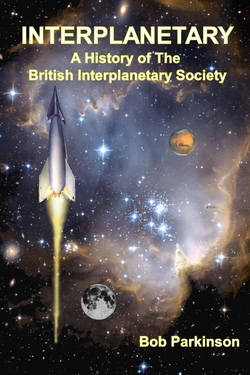Centauri Dreams
Imagining and Planning Interstellar Exploration
Life Among the Comets
It’s hard to imagine a sane human being who would choose to live in the Oort Cloud, on a colony world where the outside temperature is in the single digits Kelvin and small bands of maybe 25 each would tend to the problems of energy production and resource extraction. Human contact beyond this would be sporadic, though Richard Terra makes the case (in “Islands in the Sky,” an Analog article I referenced yesterday) that a larger community dispersed through nearby settlements would meet regularly to ensure genetic diversity and relieve isolation.
History tells us that people do all kinds of inexplicable things, and perhaps a small number of adventurers, outcasts, zealots and other dissidents would find a home here. But given the abundant resources closer to the inner system, I’m more inclined to look at the Oort Cloud as a source of raw materials for colonies on the move between stars. These would be generation ships moving perhaps no faster than Voyager 1 moves now, about 17 kilometers per second. The main point is that the space between the stars is hardly empty, and future generations with the tools of advanced propulsion may take not one giant leap but many small steps in the direction of Alpha Centauri.
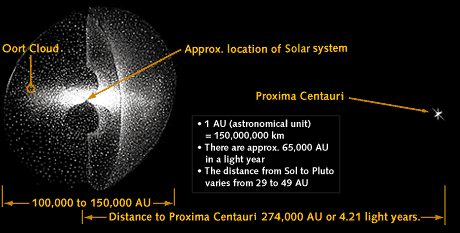
Image: The Oort Cloud in relation to the Solar System. Credit: UC-Berkeley/Comet’s Tale Development Team.
Whether we’re settlers or voyagers (and I suspect we’ll be both), we’ll learn all along the way from the experience of adapting to space. Ben Finney and Eric Jones put it this way in their paper “Fastships and Nomads” (reference at the end of yesterday’s post):
If interstellar settlement happens at all, it will come after our descendants have learned to maintain self-sufficient communities detached from Earth’s nurturing biosphere, learned to tap the knowledge and skill potential of advanced computers, learned to efficiently harness the energy that flows out of the Sun, and even learned to extract useful energy from the fusion of atoms. We are on the verge of achieving all these things. With sufficient skill and patience we will attain the stars.
Of course, we have been on the ‘verge’ for a long time when it comes to fusion. But taking the long view of human expansion and looking not just decades but centuries ahead, these words resonate.
Finding the Energy
Whichever scenario strikes your fancy, the energy conundrum is still huge. Yesterday I talked about Finney and Jones’ ideas of concentrating starlight through vast mirrors the size of the continental United States. Terra picks up on this to describe colonists living in O’Neill cylinders, each housing a band of outer system stalwarts who would tend a mirror farm stretching across 30,000 kilometers of space. Maybe ‘tending’ is the wrong word, though — robotic systems would surely do the heavy lifting with substantial human oversight. From Terra’s paper:
The primary sector of the economy — the exploitation of natural resources — is likely to be small and almost completely automated. Human involvement will be minimal. The primary sector will consist of two basic activities: energy production and the harvesting of cometary resources. Once the appropriate systems are established, both will be relatively simple activities.
The secondary sector — the transformation of the natural resources — will include refining and processing the raw cometary feedstock, manufacturing, construction and assembly operations, agriculture and food production, and recycling. Again, many of these activities will be highly automated, but closer human supervision will be necessary to tailor these activities to the current needs of the community.
Terra goes on to cite a third sector where most of the human skill set will go to work. Here he’s talking about support services that maintain the life support systems and needed repairs to the colony world. Information processing, education, administration, and eventually business and commerce between settlements will command the attention. The latter, keeping colonists in contact with other colonies, has also been proposed in various starship scenarios over the course of long voyages, with multiple ships accompanying each other on the journey.
Both Terra and Finney and Jones, of course, are talking about full time colonies rather than crews in transit. Their mirror farms are themselves components of even larger arrays, spread out perhaps 200,000 kilometers from the cometary nucleus. Growing the community would mean creating comet clusters by moving new comets into range, which would allow populations up to 100,000 or so to exist, though spread out widely through the cluster. With perhaps a light-day of separation between communities living in such clusters, the colonists would be in constant electromagnetic communication with other settlements scattered throughout the inner and outer Oort.
The Fusion Alternative
As wondrous a science fictional setting as this provides (and vast mirrors inevitably call to mind the continent-sized sails of Cordwainer Smith’s “The Lady Who Sailed the Soul”), I’d like to think there are more practical ways to produce the needed energy. But what? Fission doesn’t fly out here because the heavy elements are found in only minute amounts. Remember, we’re not talking about a colony world that is sustained by regular supplies from the inner system. We have to exploit local resources, and that takes us to the deuterium available in comets.
If fusion can be mastered, we have changed the game. In his book Entering Space: Creating a Spacefaring Civilization (Tarcher, 1999), Robert Zubrin points to the progress in both robotics and artificial intelligence that will be needed to sustain widely scattered colonies, adding that previous experience settling the asteroid belt may teach us many lessons. But he doesn’t like the starlight mirror idea one bit:
While some have suggested concentrating starlight, it doesn’t really make sense. To get a single megawatt of power, the mirror would have to be the size of the continental United States. The only viable alternative based on currently known physics is fusion. In the Kuiper Belt, it might be possible to get helium-3 shipped out from mining operations around Neptune. Oort Cloud settlements would be too far out to obtain much from the solar system, though deuterium should be available in all iceteroids, so perhaps the colonists might choose to build reactors based on that fuel alone. However, helium can exist in the liquid phase below 5 K (-268 degrees C), which is the environmental temperature at about 3000 AU. It is therefore not impossible that liquid helium could exist within Oort Cloud objects beyond that distance.
But even if we can make fusion work — and I’m assuming that a civilization that can move large payloads to the Oort Cloud is one that probably has — our isolated communities still have an energy conundrum. They’ve got a couple of centuries worth of fusion fuel in the comet cluster they’ve cultivated, but it’s still a non-renewable resource. That’s going to mean tight rationing of fusion fuels even if the technology is available, unless somehow proton fusion can be mastered. Maybe an Oort Cloud settlement of any size would have to have Finney and Jones’ mirrors after all, constructing them as the only renewable solution for succeeding generations.
Zubrin thinks wanderlust and the pioneer spirit will drive some humans outward to test out such scenarios. After all, the great bulk of human society will remain in the inner system where the warmth is, and its possible that the growing centralization and homogeneity of culture here over the course of centuries would incline the more independent-minded to emigrate. O’Neill cylinders, asteroids and comets may be the ideal home for dissident groups trying social experiments and pushing the envelope on what a human society can become. “Why live on a planet whose social laws and possibilities were defined by generations long dead, when you can be a pioneer and help to shape a new world according to reason as you see it?” Zubrin asks.
But there may be other scenarios that would force us into the Oort Cloud. Tomorrow I’ll look at a couple of possibilities that could make the outer system our stepping stone to the nearest stars.

Into the Oort Cloud: A Cometary Civilization?
Jules Verne once had the notion of a comet grazing the Earth and carrying off a number of astounded people, whose adventures comprise the plot of the 1877 novel Off on a Comet. It’s a great yarn that was chosen by Hugo Gernsback to be reprinted as a serial in the first issues of his new magazine Amazing Stories back in 1926, but with a diameter of 2300 kilometers, Verne’s comet was much larger than anything we’ve actually observed. Comets tend to be small but they make up for it in volume, with an estimated 100 billion to several trillion thought to exist in the Oort Cloud. All that adds up to a total mass of several times the Earth’s.
Of course, coming up with mass estimates is, as with so much else about the Oort Cloud, a tricky business. Paul R. Weissman noted a probable error of about one order of magnitude when he produced the above estimate in 1983. What we are safe in saying is something that has caught Freeman Dyson’s attention: While most of the mass and volume in the galaxy is comprised of stars and planets, most of the area actually belongs to asteroids and comets. There’s a lot of real estate out there, and we’ll want to take advantage of it as we move into the outer Solar System and beyond.
Comets and Resources
Embedded with rock, dust and organic molecules, comets are composed of water ice as well as frozen gases like methane, carbon dioxide, carbon monoxide, ammonia and an assortment of compounds containing nitrogen, oxygen and sulfur. Porous and undifferentiated, these bodies are malleable enough to make them interesting from the standpoint of resource extraction. Richard P. Terra wrote about the possibilities in a 1991 article published in Analog:
This light fragile structure means that the resources present in the comet nuclei will be readily accessible to any human settlers. The porous mixture of dust and ice would offer little mechanical resistance, and the two components could easily be separated by the application of heat. Volatiles could be further refined through fractional distillation while the dust, which has a high content of iron and other ferrous metals, could easily be manipulated with magnetic fields.
Put a human infrastructure out in the realm of the comets, in other words, and resource extraction should be a workable proposition. Terra talks about colonies operating in the Oort Cloud but we can also consider it, as he does, a proving ground for even deeper space technologies aimed at crossing the gulf between the stars. Either way, as permanent settlements or as way stations offering resources on millennial journeys, comets should be plentiful given that the Oort Cloud may extend half the distance to Alpha Centauri. Terra goes on:
Little additional crushing or other mechanical processing of the dust would be necessary, and its fine, loose-grained structure would make it ideal for subsequent chemical processing and refining. Comet nuclei thus represent a vast reservoir of easily accessible materials: water, carbon dioxide, ammonia, methane, and a variety of metals and complex organics.
Energy by Starlight
Given that comets probably formed on the outer edges of the solar nebula, their early orbits would have been more or less in the same plane as the rest of the young system, but gravitational interactions with passing stars would have randomized their orbital inclinations, eventually producing a sphere of the kind Jan Oort first postulated back in 1950. Much of this is speculative, because we have little observational evidence to go on, but the major part of the cometary shell probably extends from 40,000 to 60,000 AU, while a projected inner Oort population extending from just beyond the Kuiper Belt out to 10,000 AU may have cometary orbits more or less in the plane of the ecliptic. Out past 10,000 AU the separation between comets is wide, perhaps about 20 AU, meaning that any communities that form out here will be incredibly isolated.
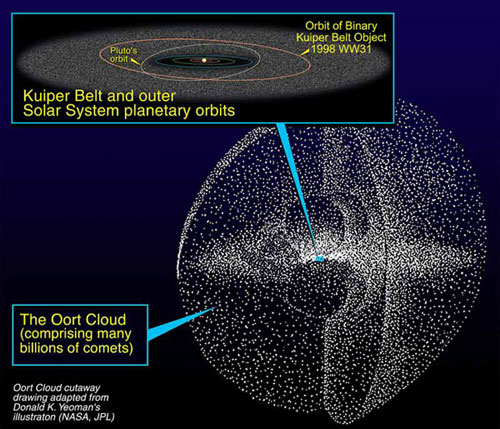
Image: An artist’s rendering of the Kuiper Belt and Oort Cloud. Credit: NASA/Donald K. Yeomans.
Whether humans can exploit cometary resources this far from home will depend on whether or not they can find sources of energy. In a paper called “Fastships and Nomads,” presented at the Conference on Interstellar Migration held at Los Alamos in 1983, Eric Jones and Ben Finney give a nod to non-renewable energy sources like deuterium, given that heavy elements like uranium will be hard to come by. Indeed, a typical comet, in Richard Terra’s figures, holds between 50,000 and 100,000 metric tons of deuterium, enough to power early settlement and mining.
But over the long haul, Jones and Finney are interested in keeping colonies alive through renewable resources, and that means starlight. The researchers talk about building vast mirrors using aluminum from comets, with each 1 MW mirror about the size of the continental United States. Now here’s a science fiction setting with punch, as the two describe it:
Although the mirrors would be tended by autonomous maintenance robots, the nomads would have to live nearby in case something went wrong… Although we could imagine that the several hundred people who could be supported by the resources of a single comet might live in a single habitat, the mirrors supporting that community would be spread across about 150,000 km. Trouble with a mirror or robot on the periphery of the mirror array would mean a long trip, several hours at least. It would make more sense if the community were dispersed in smaller groups so that trouble could be reached in a shorter time. There are also social reasons for expecting the nomad communities to be divided into smaller co-living groups.
Jones and Finney go on to point out that humans tend to work best in groups of about a dozen adults, whether in the form of hunter/gatherer bands, army platoons, bridge clubs or political cells. This observation of behavior leads them to speculate that bands of about 25 men, women and children would live together in a large habitat — think again of an O’Neill cylinder — built out of cometary materials, from which they would tend a mirror farm with the help of robots and computers. Each small group would tend a mirror farm perhaps 30,000 kilometers across.
The picture widens beyond this to include the need for larger communities that would occasionally come together, helping to avoid the genetic dangers of inbreeding and providing a larger social environment. Thus we might have about 500 individuals in clusters of 20 cometary bands which would stay in contact and periodically meet. Jones and Finney consider the band-tribe structure to be the smallest grouping that seems practical for any human community. Who would such a community attract — outcasts, dissidents, adventurers? And how would Oort Cloud settlers react to the possibility of going further still, to another star?
More on this tomorrow. For now, the Terra article is “Islands in the Sky: Human Exploration and Settlement of the Oort Cloud,” Analog June, 1991, pp. 68-85. The Jones and Finney paper is “Fastships and Nomads,” in Finney and Jones (eds)., Interstellar Migration and the Human Experience, University of California Press (1985), pp. 88-103.

The British Interplanetary Society at 80 Years: Part II
by Kelvin F. Long
The chief editor of the Journal of the British Interplanetary Society here offers part II of his article on the Society’s history. If there is one BIS project that captures the imagination above all others, it’s surely Project Daedalus, the ambitious attempt to design a spacecraft capable of reaching a nearby star within 50 years. But the motivations for Daedalus were wide-ranging and the conclusions of the study may surprise you. The success of the design effort showed us what was possible with the technology of its time, while subsequent studies like Project Icarus upgrade the vessel and take us that much closer to what may one day be a working craft.
Les Shepherd took things to new heights with the publication of his seminal 1952 paper “Interstellar Flight”. This was the first paper ever to properly address the physics and engineering issues associated with sending a probe to another star and it is what I regard as the beginning of interstellar studies as a subject. This brings us to one of the seminal studies of the society, Project Daedalus. Speaking to people about the Project Daedalus study, it is clear that many today don’t fully appreciate the real motivation behind it, which was the Fermi Paradox. This is the apparent contradiction between our theoretical expectations for intelligent life in the universe and our lack of observational evidence.
One of the ways to begin to address this is just to ask if it is even possible to travel between the stars (just like the BIS had earlier asked if it was possible to conceive of a machine to travel to the Moon). So the Daedalus team spent five years (mostly in pubs) designing the 50,000 ton unmanned probe capable of reaching 12% of the speed of light. Their guiding principle was to find a balance between being sufficiently bold and being sufficiently credible. This meant that the design had current technology (1970s) and extrapolated technology (few decades hence).
The approach naturally led to design contradictions (i.e. vacuum tubes next to an AI computer) and was the main limitation on the fidelity of the design integration. But most would agree the team did a pretty good job. As Centauri Dreams readers are familiar with Daedalus by now, I won’t go over the design itself, except to say that it would be a 450 ton flyby probe that was delivered to the Barnard’s Star system, 5.9 light years away after a journey lasting around half a century. At the end of the study the team concluded that if at the outset of the space age we can conceive of a machine such as Daedalus where interstellar flight appeared to be possible, then it is likely that in the coming centuries we could derive a more credible and practical design.
On the basis of this, they concluded that interstellar travel was therefore feasible, and so the explanation for the Fermi Paradox may lay in some other solution (i.e. the prevalence of biological life). But Daedalus was the first study to prove that interstellar flight was possible.
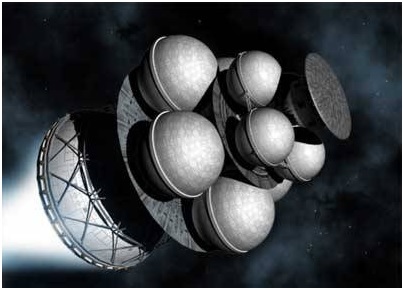
Image: The BIS Project Daedalus, a modern illustration. Credit: Adrian Mann.
Anyone who studies aerospace engineering knows that a vehicle design goes through three levels of iteration. First is the concept design phase, which addresses whether it will work, what it looks like, what requirements drive the design, what trade-offs should be considered and what mass it should have — and if necessary how much it would cost. The next level is the preliminary design phase, which freezes the configuration, develops any vehicle sizing, creates the analytical basis for the design and moves into experimental demonstrations if appropriate. The final level is the detailed design phase, which identifies the individual pieces to be constructed. This includes any tools required. It involves any critical design tests of the structure and finalizes the vehicle configuration layout and performance specification.
Along the way, there is a process of integrating the various systems and subsystems, today couched in the language of systems engineering. In my opinion the Daedalus was an early preliminary vehicle design for a starship. The team defined all of the major systems and most of the subsystems. Full integration was not possible due to the nature of the technological extrapolation. But the vehicle configuration layout, performance specification and mission profile were defined in full where practical to do so.
During my own reading of interstellar concepts, I have come across solar sail-driven methods, laser beaming, microwave beaming, fusion, antimatter and exotic concepts, to name a few. All of these studies have been concept papers, however, or proposal submissions, or case study analyses – they do not constitute designs. I argue that at best they are concepts and for most of them even that term is not fully justified due to errors in the calculations or the gaping areas of engineering or physics not addressed. Daedalus is the only one that can be claimed to be a “starship design” in my view. The only other vehicle that comes close to it is the Project Orion design from the 1950s and 1960s. Orion certainly was a preliminary design, but it was calculated for an interplanetary mission only. Then there were the worldship studies from the 1980s by Alan Bond and Anthony Martin, but these did not go into the sub-system level of the internal architecture. Daedalus was first, and Daedalus remains the only one
On a recent visit to NASA Marshall Space Flight Center, NASA Glenn Research Center and the Tennessee Valley Interstellar Workshop, I challenged people to refute my controversial (and deliberately provocative) claim that Daedalus is the only starship design in history. NASA appeared to agree with me. This is an astonishing revelation and I find it intriguing that people are prepared to pronounce interstellar flight impossible when we have only attempted one such design in history. More feasibility studies are clearly required before we can have a clear picture of what the impossibilities or otherwise are.
There are three profound implications that come out of the Daedalus study which I think are worth highlighting again because they are so important:
- That interstellar travel appears to be entirely feasible in theory and so in the future will likely be feasible in practice.
- That because interstellar travel is feasible, the absence of any observation of intelligent life in the universe suggests we must seek alternative explanations.
- That Daedalus was the first and so far only starship design in history and remains so to this day (until the completion of the Project Icarus study anyway).
In the light of history and developments in astronomy, I suppose an important addendum should now be added to the Daedalus study, which is that a flyby is probably not the way to send a probe to another star. This was the view of the Project Icarus team early on, which is why we made deceleration an engineering requirement for the mission. We live in an age where exoplanets are discovered almost weekly, orbiting around other star systems. In the future we should be able to fully characterise those planets, including their stellar atmospheres, using Earth orbiting or lunar based deep space observatories, so the benefits of flyby must be justified from both a performance and cost basis. In order to add value to an interstellar mission, it is more beneficial to send a probe that can release atmosphere penetrators and planetary landers into the local system, accessing the surface that deep space platforms from Earth cannot reach.
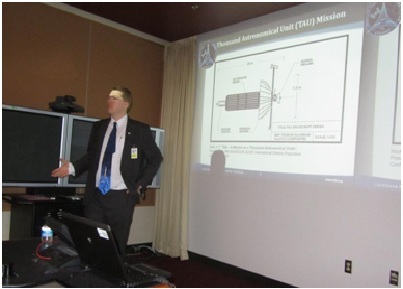
Image: Kelvin F.Long lecturing at NASA Marshall Spaceflight Center, February 2013.
Numerous other BIS projects have been in play, the earliest being development of a coelosat in the 1930s, a device capable of effecting navigation by the stars. Ken Gatland invented the idea of the MOUSE launcher from 1948-1950. The lunar lander underwent various developments by Ralph Smith from 1947-1952. Smith also developed the concept of a space station with Harry Ross from 1948-1958. He also designed a manned orbital winged rocket in 1950. Les Shepherd and Val Cleaver wrote some of the first pioneering papers on atomic rockets from 1948-1949. Arthur C Clarke was also busy during this period, designing his electromagnetic lunar launch system in 1950 and the atomic interplanetary spaceship in 1952. His spaceship design was shown in several popular space books by himself, Gatland and others around that time and it has a striking resemblance to the Ares, the vehicle that features in Clarke’s book The Sands of Mars and also the Discovery I which is the design featured in 2001: A Space Odyssey.
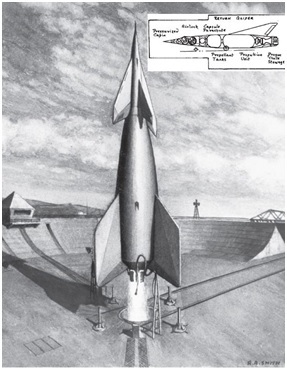
Members of the BIS have also been involved in various spin-off projects such as the 1980s HOrizontal Take-off and Landing (HOTOL) project initiated by people like Bob Parkinson at British Aerospace and Alan Bond, then at Rolls Royce. Bond went on to found Reaction Engines Ltd and to develop the groundbreaking Sabre engine, the critical technology required in order to make a vehicle like Skylon (the successor design to HOTOL) technically credible. Charles Cockell launched Project Boreas in 2001, an initiative to design a human habitat at the geographic Martian north pole. The project featured luminaries such as the astronomer Ian Crawford and the science and science fiction author Stephen Baxter, all dedicated members of the society. Other big names have been members of the society throughout its history, including Bob Zubrin, the guy that radically changed our thinking on how to do Mars missions more than anyone. In the 1980s he was regularly communicating with the BIS planetary engineering (terraforming) expert Martyn Fogg, who was then arguably the world authority on the subject.
Image: The BIS Winged Orbital Rocket. Credit: BIS.
I mustn’t forget Olaf Stapledon of course. I am unsure if he ever joined as a member but his famous 1948 lecture on “Interplanetary Man” at the invitation of Clarke was one of those world events that anyone would have wished to attend. I wasn’t born then but was fortunate to meet Stapledon’s grandson Jason Shenai last year. Jason came to the BIS to attend the “Starmaker” symposium which the Technical Committee had organised.
The above are just some examples of major projects the society has pioneered as feasibility studies in the early years, all of which (except for the interstellar probe and SSTO) came to fruition, showing that the society played a vital role in engineering the future. This is what Arthur C.Clarke refers to as “creating a self-fulfilling prophecy,” and this can be achieved by the adoption of positive and optimistic advocacy.
My own entry into the BIS (and indeed the space/interstellar community) was the organisation of the Warp Drive conference in 2007. Speakers came from across the world to London to discuss the developments since Miguel Alcubierre’s seminal 1994 paper. This is where I first met Claudio Maccone and Richard Obousy. It was with Richard’s assistance that we both went on to found Project Icarus, with the goal of catalysing the interstellar community. Those were exciting days. When we look around us at the many interstellar related organisations working on the goal of starflight, we can be proud of our efforts and know that we played some role. Project Icarus was always intended as part designer training exercise more than anything, recognising that there was a lack of design capability to actually work on starships at the time.
The other purpose of the project was to inspire people young and old to believe in the dream of star travel once again. Project Icarus is still on-going as a joint British Interplanetary Society project with the US non-profit Icarus Interstellar, who now manages the project until its completion. Icarus Interstellar have gone on to found many other design projects, taking our original ambitions to a new and hopeful level and I’m proud to have played a role in its foundation. I have also now moved on to found the pending Institute for Interstellar Studies. We and all the interstellar organizations are building the vital industry needed to make interstellar happen at some point in our not too distant future.
On the 13th October 2013 the British Interplanetary Society will be 80 years old. When I consider the achievements of the BIS throughout its history, I am also forced to consider its function. The society is clearly not a science fiction society, but it is also clearly not a commercial space organisation. As a registered charity, I find that its function is in fact unique, in that it exists between both of these worlds. It stands in the metaphorical corridor between “imagination” and “reality” and this is in fact its motto: “from imagination to reality”. People have ideas, concepts, designs, they bring to the BIS and the various mechanisms (lectures, publications, symposia) will help to catalyse those ideas and then to bring them to the attention of wider industry, government and academia.
Nothing exemplifies this more than the example of the BIS Lunar Lander. One wonders whether Daedalus and the Project Icarus study are playing the same role today but for interstellar flight. We also have a role to point the way, to act as a compass direction for future achievements. To help to convince industry, government, academia, the public and the media that something is possible, where the data may have previously suggested it was not. In this way, we encourage innovations and breakthroughs which can lead to new technologies, industries or processes, and thereby greater achievements in the exploration of space.
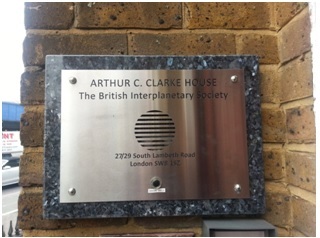
The HQ building in London is now officially called “Arthur C.Clarke House”, and Clarke twice served as President of the society (then called Chairman) in the years 1946-1947 and 1951-1953. He remains our most inspirational member and we are very proud to carry on with his legacy. It may surprise many to know that although the BIS is the oldest space organisation in the world, it has also been struggling to survive through challenging financial times. Despite this it has continued to serve a vital role for the community at large. The technical publication JBIS, for example, is famous for the publication of its “red cover” issues on interstellar studies from 1974-1991 (we have recently been issuing new red cover volumes), and it has remained the torch holder of the interstellar vision through the decades.
Image: The BIS door bell. Credit: BIS.
Where else would all of those creative talents have found a home for their pioneering and speculative publications on starship design or the Search For Extraterrestrial Intelligence (SETI)? However, don’t despair, as things are looking up with the election of an inspirational new President, Alistair Scott, who has a charismatic military-based leadership style, from his experience as an Army officer. He originally studied aeronautical engineering at university and after several exciting positions in industry he settled for many years at the satellite company Astrium. Scott is applying this huge experience to driving the recovery of the society, literally running the committees like they were platoons within a regiment. Yet he is as down to Earth and charming as they come and a complete gentleman, showing respect and warmth for all people no matter their background or rank. He is supported by his loyal team, including Vice Presidents Mark Hempsell (Reaction Engines Future Programs Director), Chris Welch (International Space University Professor) and Suszann Parry, the Executive Secretary.
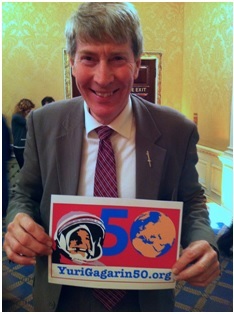
The society has many new and exciting projects coming online under the supervision of Technical Committee Chairman Richard Osborne, a pioneer of amateur rocketry himself. The BIS is participating in Project KickSat, which is an initiative by Zac Manchester out of Cornell University in the US to place a fleet of ChipSats or Sprites into Low Earth Orbit sometime this year. The BIS members put several thousand pounds into the project, which is now managed with enthusiasm by Andrew Vaudin. The society is also launching Project 2033 (managed by myself), a competition to imagine the future state of space exploration at the society’s centennial anniversary. Sir Arthur C Clarke is famous for his ability to see into the future and predict technology trends. We are hoping to find the next visionary and to see twenty years from now who gets it right. We have recently launched Project STARDROP, which stands for Solar Thermal Amplified Radiation Dynamic Relay of Orbiting Power, which aims to design a 10 GW solar collector power system to run an L5 space colony. This is now being managed by Ian Stotesbury. The past projects of the BIS are outstanding but we are looking towards the next horizon in space.
Image: The BIS President Major Alistair Scott. Credit: BIS.
Things seem to be changing in Britain for the better with government attitudes towards space exploration being much more positive. We now have our own United Kingdom Space Agency (UKSA), our own European Astronaut Tim Peak (Britain’s first official astronaut), and as if things could get any better, it was recently announce that a UK industry team in cooperation with UKSA is investigating whether Britain should have its own spaceport…and launch vehicle (yes, you read that right). The company Reaction Engines already has an answer to this of course, with its innovative Single Stage To Orbit (SSTO) spaceplane design. The company recently announced critical breakthroughs relating to the pre-cooler technology which has previously prevented similar concepts becoming reality.
We may be the oldest space organisation in the world, but we are also a thriving organisation, making changes to ourselves so as to better serve the modern technological world. We would love for new people to come and join us and be a part of this great society, with its global outreach and impact. We are particularly looking for members in the US or elsewhere to start BIS branches. The history above proves that the BIS does engineer the future. If this is attractive to you too, and you are interested in being a catalyst to our own determined self-fulfilling prophecy, then you will find a home with the BIS. We welcome new members who want to help take imagination to reality. Be unique, and join the British Interplanetary Society, because it’s where the future is made. And the next time you are in London, be sure to pay us a visit.
Finally, I want to end this article with a donations appeal. The BIS is a registered charity and we are all volunteers, including me, yet I manage to run the journal and keep the papers moving. Our financial demands are high and this has impeded our ability to meet the mission. If you believe that the British Interplanetary Society’s role in astronautics has been and continues to be important, then please consider making a donation and we will carry on doing it. Ad Astra.
==
Donations to the BIS can be made here:
http://www.bis-space.com/products-page/donation/
The main BIS web site is located here: www.bis-space.com
The Technical JBIS web site is located here: http://www.jbis.org.uk/
The information on past BIS projects was partly borrowed from the BIS book Interplanetary by Bob Parkinson and incorporates edited information from articles from the August and September 1967 issues of the BIS magazine Spaceflight. The book is available for purchase here: http://www.bis-space.com/products-page/books/

The British Interplanetary Society at 80 Years
by Kelvin F.Long
Centauri Dreams readers will know Kelvin Long as the Chief Editor for the Journal of the British Interplanetary Society, but the résumé hardly stops there. He is also the Deputy Chair of the BIS Technical Committee and a member of the governing council. Long is the co-founder of Project Icarus, co-founder of the non-profit Icarus Interstellar (formerly serving as the Vice President European Operations) and is the co-founder of the pending Institute for Interstellar Studies. He is the managing Director of the aerospace company Stellar Engines Ltd. Here Kelvin begins a two-part article (to be completed on Monday) highlighting the British Interplanetary Society and its numerous contributions to spaceflight concepts both interplanetary and interstellar.

Liverpool is a unique location in British history. Not just because of the Beatles or Olaf Stapledon, but because this is where the British Interplanetary Society (BIS) was founded in 1933 by a Cheshire-born engineer, Philip E.Cleator. Impressed with the rocketry efforts in the US and Germany, he took the initiative to form a UK based rocket society and he published his article “The Possibilities of Interplanetary Travel” in Chambers Journal in January 1933. This was subsequently picked up by the Editor of the Liverpool Echo and eventually by the national press in the form of the Daily Express. This led to a front page feature and the gathering of a small collection of local people at his home.
The decision was then made to set up the British Interplanetary Society. The inaugural meeting of the society took place at the office of H.C.Binns on the second floor of No.81 Dale Street, Liverpool, on Friday 13th October 1933. It was not until the end of 1945 that the articles of the reformed BIS were drafted (the society was suspended during the war) and the society registered as a limited company. It was in 1936 that the London section was formed and this eventually became the main headquarters the following year. For the record, the Journal of the British Interplanetary Society was founded in 1934 and is the oldest astronautical journal in the world. The society’s popular space magazine Spaceflight (now edited by David Baker) was founded in 1956 (a year before Sputnik 1), and remains at least one of the oldest space magazines still in existence (today the BIS also publishes the space history journal Space Chronicles (1980), edited by John Becklake, and the science fiction based e-magazine Odyssey (2011), edited by Mark Stewart.
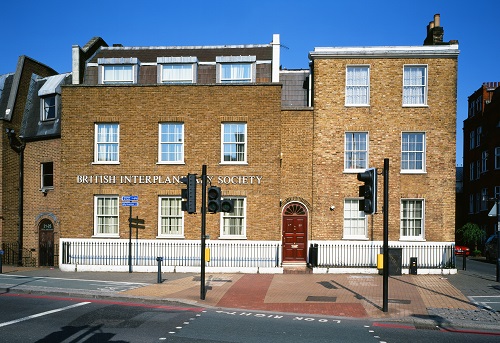
Image: Current headquarters of the British Interplanetary Society at 27/29 South Lambeth Road, London. Credit: Colin Philp.
The society grew from those early foundations and some of the earlier members included people like Arthur C. Clarke, Les Shepherd, Eric Burgess, Ralph Smith, Harry Ross, Ken Gatland, Val Cleaver and later on Patrick Moore. For anyone who knows their space history, all of these people have had huge impacts on the development of space technology or in helping to communicate and advocate for the exploration of space. Clarke pioneered the idea of the telecommunications satellite as well as writing world class science fiction; Eric Burgess was the first to suggest to Carl Sagan that a message for ET could be included on the Pioneer spacecraft; Val Cleaver was the inventor of the British rocket engine that went into the Blue Streak missile; Gatland, Smith and Ross were all pioneers of rocketry, satellite payloads and space architectures; Les Shepherd was a pioneer of nuclear propulsion and eventually went on to be the president of the International Astronautical Federation (IAF), an organization that included the BIS as one of its founding members in 1951.
According to the Memorandum of Association:
“The objects for which the British Interplanetary Society is established are to promote the advancement of knowledge and the spread of education and particularly to promote the advancement and dissemination of knowledge relating to the science, engineering and technology of Astronautics and to support and engage in research studies and to disseminate the useful results thereof and in furtherance thereof…to hold meetings, promote exhibitions, publish reports, make awards, medals or grants, to provide funds for educational and academic activities in furtherance of its objects”.
In order to understand the crucial role that the British Interplanetary Society has played in the history of space exploration, it’s worth looking at some examples from the society’s rich technical history.
The BIS Moonship
For years people had dreamed about visiting the Moon and some even wrote about it. Jules Verne originally wrote From the Earth to the Moon in 1865. This is a fascinating tale of a group of people who build an enormous space gun and launch themselves in a projectile spaceship all the way to the Moon. Verne had apparently done some calculations for the mission, although the particular method lacked the safety we have come to expect for man-rated vehicles – it is not likely the crew would have survived the trip. H.G.Wells made an interesting attempt at lunar flight in his 1901 story The First Men in the Moon. The vehicle would use a mysterious substance called “Cavorite” which would negate the force of gravity to effectively give the vehicle its required lift properties and allow a visit to the extraterrestrial civilization of insect-like creatures inhabiting the Moon known as the Selenites.
These were wonderful works of the imagination but could we come up with anything that resembled reality? So it was that in 1938, the BIS Technical Committee decided to go the full distance and produce a conceptual design of a vessel that would carry a crew of three safely to the Moon, permit them to land for a stay of fourteen days, and provide for a safe return to the Earth with a final payload of half a ton. The object of the exercise was to demonstrate that, within the capabilities of propellants that could be specified (at least theoretically) at the time, such a mission was not merely possible but would be economically viable – insofar as the vehicle lift-off mass from the Earth would be no more than one thousand tons. The conceptual design that resulted came to be known as the BIS Lunar Spaceship, and for all its flaws and misconceptions it must be regarded as one of the classical pioneering studies in the history of astronautics.

Image: BIS Moonship and Lander. Credit: British Interplanetary Society.
The mission proposed for the Lunar Spaceship would involve total velocity changes in excess of 16 km/s, a figure that would be significantly increased by certain losses. The best available propellants were not expected to achieve rocket motor efflux velocities of one quarter of that figure. This enormous disparity implied that, if one attempted to achieve the entire mission with a simple single-stage vessel, 99% or more of its initial lift-off mass would have to consist of the propellant. (In the more common parlance of rocketry this required a mass ratio exceeding 100.) The most enthusiastic proponents of space flight were at one with their critics in dismissing this as inconceivable. To circumvent the problems, the pioneers of astronautics invented the Step Rocket, in which the vessel consisted of a series of stages of diminishing size, fired in sequence. As each successive stage completed firing, its engines and other redundant structure would be discarded leaving the higher stages to continue the flight.
In this way it would be possible to obtain a high mass ratio without invoking the need to achieve impossible structural factors. Looked at in another way, the total velocity change required of the overall vessel would be shared between the stages. In this case, four equal stages would each need to contribute little more than 4 km/sec to the total velocity change. That would be possible with the performance of known propellants. The proportion of the stage mass taken up by propellant would assume a reasonable level (say, 75%, corresponding to a mass ratio of 4). However, a penalty would be incurred in the final payload, which would be reduced in inverse proportion to some number raised to the power of the number of stages. Optimistically, at the time, that number might have been taken as 10. Thus, with four stages, the final payload might be expected to be only one ten-thousandth of the lift-off mass. The nub of the argument of the more informed critics of such a lunar flight would have been that such a mission would probably have required as many as five stages, perhaps more, so that the initial vessel would have had to match an ocean liner in size to carry an ultimate payload of one ton. Such a mission could not be viable.
In 1919 Robert Goddard, in his classic paper “A Method of Reaching Extreme Altitudes”, went a stage further than the step rocket principle in suggesting a firing procedure that amounted to the continuous discarding of redundant structure. This procedure, in principle, could result in a significant improvement in payload ratio compared to the step rocket. The BIS, in its design concept, adopted a cellular construction that, in essence, conformed to Goddard’s suggestion.
The BIS Space Ship was described in the January 1939 Journal by H.E. Ross. The vessel was divided into six tiers (steps) of equal hexagonal cross-section and the six sections were made up of an array of tubes each consisting of separate rocket motors. Each of the lowest 5 steps was made up of 168 motors, intended to impart sufficient velocity to achieve escape from the Earth’s gravitation. The remaining stage consisted of 45 medium motors and 1200 smaller tubes intended to land the remainder of the vessel on the Moon, allow for subsequent escape from the latter (leaving redundant structure on the surface of our satellite), and for reduction in velocity prior to entering Earth’s atmosphere. Perhaps the most important lasting achievement of the Lunar Spaceship study, however, came from its conclusions regarding the landing upon, and lift-off from, the lunar surface. R.A. Smith developed the concept after World War II in an article – “Landing on an Airless World” – published in the August 1947 BIS Journal, accurately depicting the procedure that was to be adopted with the Apollo Lunar Excursion Module. The only notable difference between the two cases was, perhaps, that Smith’s design was more elegant than the actual LEM.
The Technical Committee decided that its activities should embrace an experimental programme to support its Lunar Spaceship concept. From the outset, it rejected the experimental “firing of free rockets” as valueless on account of their small scale and lack of control over the many parameters involved in such flights. It made no attempt, therefore, to emulate the VfR [the German Verein für Raumschiffahrt, or Society for Space Travel] or later American groups. The BIS workers considered that the development of rocket motors for their proposed lunar mission would have to proceed in stages, beginning with literature and experimental studies of possible propellants, followed by the design of chambers and nozzles on the best theoretical basis – the work of Sänger was cited as noteworthy in this respect.
The resulting motors and selected propellants would then be brought together in static proving stand firings in which all the variables could be systematically controlled and measured. The intention was correct and logical, but even the over-optimistic members of the Technical Committee were bound to note that such a program was far beyond their resources. Nevertheless, largely under the supervision of Janser, who was a research chemist, they embarked on the preliminary stages of the propellant survey hoping that eventually they would solicit sufficient support from public benefactors, convinced by the evidence emerging from the Lunar Spaceship study, to proceed with serious development. Undaunted, R.A. Smith designed a basic test stand that was actually constructed. Despite some shortcomings, the program of the Technical Committee was a laudable endeavor.
The BIS Space Suit
In a November 1949 symposium, Harry Ross presented a paper on the “Lunar Space-Suit”. Ross had examined the problem of a 68 kg lunar space suit (equivalent to 11 kg on the Moon) which could be worn for up to 12 hours, within the temperature range of 120 degrees to minus 150 degrees Celsius, representing night and day. The suit design was 4-ply, made up of a thin exterior skin of closely woven cloth. It had a 1 cm layer of cellular heat-resisting material (Kapok, wool, felt et cetera) and a 1-2 mm main airtight sheath of fabric-backed natural or synthetic rubber. It also had an interior lining of non-hygroscopic material, mainly for comfort and to manage contact between the rubber and skin and absorption of the water-vapor.
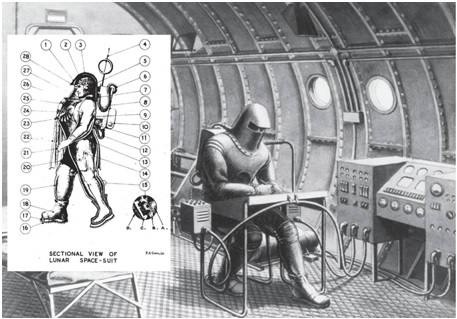
Image: The BIS Space Suit. Credit: British Interplanetary Society.
The exterior of the lunar space suit was to be a highly burnished metallic film, designed to reflect as much heat as possible. The chest and thigh areas were to be given an external matt-black finish to manage heat loss. Operation of the suit during the lunar day would require further cooling through the use of a low boiling liquid such as ammonia or water – which would vaporize to space through a thermostatic valve. The helmet was to be a light, rigid double-shell structure, with the inner a bright alloy metal and the outer a plastic with burnished metal coating. Lateral vision of 180 degrees was proposed with a minimal vertical extension in order to minimize heat gain or loss. A special glass to prevent heat and actinic ultraviolet rays would be employed. There would be further precautions, including providing the helmet with a shading peak and an external moveable visor made either of darkened glass or bright metal pierced with cross-slits in front of the eyes. The suit was to be a good fit to ensure maximum comfort and the shoulders would be internally padded.
Considerable thought went into the problem of air-conditioning, as discussed by Bob Parkinson in his book Interplanetary:
“Compressed (bottled) oxygen was regarded as simplest, and Ross recognized that a skin-tight suit with bottled oxygen flushing to waste might be sufficient, the weight of even a 12-hr supply not being excessive. However, a pure liquid oxygen supply was suggested, with the atmosphere maintained at about 160 mm Hg (21 kPa). The suit’s atmosphere was to be circulated through the conditioning units and throughout the dress by an electric fan-pump driven by the electric battery. Respired carbon dioxide was to be removed by chemical means – sodium peroxide being preferred because the reaction yielded oxygen, reducing the generous allowance of 0.78 litres per min by as much as 43% – as against, for example, sodium hydroxide, where there is no regain. The sodium peroxide would also absorb water, of which it was assumed the lungs and skin would yield some 108 gm/hr”.
The space suits that were eventually worn by the Project Apollo astronauts are a far cry from this original 1940s design. But the work started out by Harry Ross led to credible thinking on how humans could survive in a self-contained, mobile habitat. The original paper by Harry Ross is titled “Lunar Space Suit,” Journal of the British Interplanetary Society, Vol.9, No.1, pp.23-37, January 1950
Project Megaroc
The “Megaroc” man-carrying rocket proposal had been put forward by R.A. Smith in 1946 after H.E. Ross observed that the V-2 was “nearly big enough to carry a man.” The objective was to provide manned ascents to a maximum of 304 km (one million feet). During flight, it was proposed that scientific observations could be made of the Earth and the Sun, that radio communication through the ionosphere could be tested, and that data should be collected on human performance over a wide range of g-conditions. The project was submitted to the Ministry of Supply on 23rd December 1946, but rejected. The proposal has remarkable similarities to the subsequent American Mercury project. Where differences do occur, they generally arise from the fact that Megaroc was much less ambitious, not being designed for orbital flight.
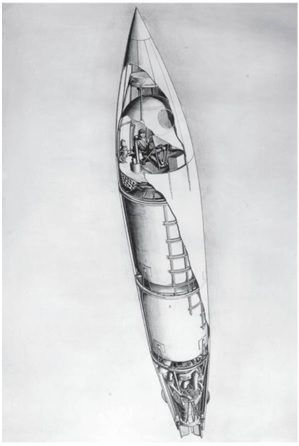
The Ross and Smith Megaroc was a modified, enlarged and strengthened V-2. The normal motor was retained but the tank diameter was increased and the end walls strengthened to accommodate enough propellant for 110 sec at full thrust, and a further 38 sec at constant acceleration. This brought the maximum hull diameter up to 2.18 m. The graphite efflux control vanes were retained, enlarged, and given the extra duty of imparting a slow stabilizing spin to the rocket. On the other hand, the big aerodynamic fins and associated controls were omitted, saving some 320 kg of weight. This was, indeed, one of the first big rocket designs in which aerodynamic fins were omitted – a feature not generally adopted in practice for another ten years.
Image: The BIS Project Megaroc. Credit: British Interplanetary Society.
The standard turbo-pump was retained but turned through 90°, rotating about the major axis of the rocket to prevent the turbine promoting tumbling after fuel cut-off. In place of the instrument bay and warhead there was a pressurized cabin, enclosed in a streamlined, jettisonable nose cone. This brought the overall length of the rocket up to 17.5 m. The launch weight was 21.2 tons. The cabin, with a return weight of 586 kg, had two large side-ports for access, observation and egress.
There was also a “strobo-periscope” (a modified form of the BIS’ pre-War coelosat, which was an experimental device to examine the possibilities of interstellar navigation) for rearward viewing after the rotating cabin had separated from the hull. Mercury’s one-ton double-walled titanium cabin started off with a topside escape hatch, two small ports and a periscope. However, the hatch was later more conveniently situated, like Megaroc’s, in the side of the cabin and arrangements were made for picture-window visibility. Megaroc’s observer was to wear a standard high-altitude g-suit, with its own air-conditioning unit and personal parachute. No other air-conditioning was proposed owing to the short duration of the flight. Although both used a cradle-type seat with integral controls, the Mercury cradle was fixed while Megaroc’s was counterbalanced and designed to tilt. The cabins of both rockets were attitude-stabilized by hydrogen peroxide jets, and both were fitted with automatic, manual and emergency controls, differing mainly in that the Megaroc was designed for a less hazardous mission.
Mercury’s cabin was provided with a heat shield against frictional heating upon re-entry to the atmosphere, retro-rockets and parachutes for braking and descent. Megaroc needed no special heat shield and relied on a reefing parachute ejected by spring flaps and a compressed air charge to provide constant drag irrespective of air-density and velocity of descent. Megaroc’s cabin was suitable for either sea or land impact and was fitted with a crumple skirt to absorb some of the shock and avoid bounce with a quick-release mechanism for the parachute. The maximum ascent acceleration imposed on the Megaroc observer was 3 g (for Mercury the figure was 9 g).
Megaroc would be launched from a tower inclined at an angle of 2° from the vertical with an initial acceleration of 9.8 m/sec2. Constant thrust would be maintained for 110 sec when the rocket would have reached 46,000 m, and the effective acceleration would have become about 20 m/s2. At this point the pilot would be experiencing 3 g, the limit at which it was thought that operational duties could be satisfactorily discharged. The pilot would actuate the fuel controls at this point to progressively reduce thrust and keep the g-meter reading constant. In case of emergency at any stage of the flight, relaxation of the pilot’s grip would switch the rocket from manual operation to automatic radio-telecontrol from the ground.
When the air-density had reduced to a point where drag was negligible, a pressure operated release mechanism would unlatch the nose-cone sections ready for jettisoning. At some subsequent moment the pilot would operate a compressed-air charge to drive the cabin and hull apart. This would also initiate operation of a delay mechanism for ejection of the hull-recovery parachute.
The control connections between cabin and hull would uncouple automatically on separation and the communication system would be switched from the four-dipole arrays arranged in blisters near the stem of the hull to arrays situated under the floor of the cabin. Cabin attitude and rate of spin would be controlled by hydrogen peroxide jets. It was thought that the pilot would therefore be able to carry out experiments with various values of g, down to zero, including free movement inside the cabin, and would be able to turn the cabin stern-down for re-entry into the atmosphere. The apex of the trajectory would be attained about 6 min 16 sec after launch and the cabin’s constant-drag parachute was to be ejected in descent at an altitude of about 113 km, the maximum deceleration imposed on the pilot being calculated as 3.3 g. The parachute would be fully extended on approaching touchdown, when it would be released to prevent the cabin from being dragged along.
It was appreciated that the Megaroc project would need to progress through a series of preliminary experiments to test the practicality of the design. For example, the modifications to the turbine and fuel control, and the endurance and reliability of the motor under the prolonged running conditions would need to be verified. The efficiency of other special innovations, such as the crumple skirt, variable-area parachutes and strobo-periscope were also to be tested. An operational mock-up of the cabin was proposed, to be suspended by a cable so that the pilot could be trained in control of orientation and spin. The pilot would also be trained in the telecontrol of an unmanned rocket and cabin assembly in free flight. Manned ascents to progressively increased altitudes were to be undertaken before attempting the maximum terminal altitude of over 1,000,000 ft (304 km).
End of part one. Part two follows on Monday.

Voyager: Looking Backward and Forward
The Voyager spacecraft have run into their share of problems as they move toward true interstellar space, but on the whole their continued operations have been a testament to what well designed equipment can do. Voyager 2’s camera platform locked for a time not long after the Saturn flyby but controllers were able to restore the system by experimenting with similar actuators on Earth. Three years ago the craft began having data problems resulting from a flipped bit in an onboard computer but a reset from Earth corrected the fault. Even the failure of the primary radio receiver not long after launch was resolved by the use of the onboard backup.
Obviously both craft are living on borrowed time as the power output of their radioisotope thermoelectric generators (RTGs) continues to decline, but we should still be getting signals for another decade or so. With the Voyagers now on what is designated their ‘interstellar mission,’ it’s pleasing to note that Alpha Centauri is the guide star that Voyager 1 used to reorient itself to resume transmissions to Earth following 2011 maneuvering to allow better detection of the solar wind. We continue to push deeper into a region of space that is now little understood.
Leaving the Solar System
Yesterday’s brief skirmish over Voyager 1’s true situation tells us how much we have to learn about the Solar System’s edge. A paper by William Webber (New Mexico State) and the late Frank McDonald (University of Maryland) reported that a sudden change in cosmic rays detected by Voyager 1 last summer showed that the spacecraft was in a new region of the Solar System they called the ‘heliocliff.’ What evidently confused matters was that the American Geophysical Union, publisher of Geophysical Review Letters — the publication at which the paper had been accepted — sent out a news release saying the craft had left the Solar System.
While the cosmic ray changes were marked, with galactic cosmic ray intensity suddenly doubling last August, Caltech’s Ed Stone issued a statement saying that a change in the magnetic field will be the true indication of Voyager 1’s arrival in interstellar space. No such change has yet been detected, and the AGU soon revised the news release headline to say that the spacecraft had ‘entered a new region of space.’ The ‘heliocliff,’ in other words, is apparently the same region that NASA scientists had already noted as a previously unknown ‘highway’ of magnetic particles. Nancy Atkinson straightened all this out quickly on Universe Today.
So Voyager 1 hasn’t yet left the Solar System, even if it is in a curious boundary region we’re still learning about. Stone said last December that he believes true interstellar space may be months or at most a couple of years away. Whenever the transition does occur, it will mark our species’ first penetration of the realm beyond the heliosphere, and we’re fortunate indeed to have two spacecraft still functional enough to report back their findings as it occurs. After all, the Voyagers were never designed to be interstellar craft and have far exceeded our expectations.

Image: The launch of Voyager 1 on September 5, 1977. Credit: NASA.
Voyager and the Archaeological Record
Meanwhile, another take on the Voyagers was offered up last January at the World Archaeology Conference in Jordan, where the spacecraft were treated as artifacts of our civilization. Colleen Beck (Desert Research Institute) and Ben McGee (Astrowright Spaceflight Consulting LLC) looked at the probes as meaning-bearing objects with or without their famous ‘Golden Records,’ markers of the culture that made them. Their presentation was titled “The bottle as the message: Solar System escape trajectory artifacts.” Matthew Battles uses Beck and McGee’s work as a launching pad for his own insights into the Voyagers in The Ache for Immortality.
Surely the Golden Records will never be snared by an extraterrestrial civilization, but compiling them taught us much about ourselves and our need to be remembered. Carl Sagan wrote about the Golden Record project in Murmurs of Earth (1978) where, Battles reminds us, he invoked the name of Esarhaddon, a 7th C. BC Assyrian king who saw to it that plaques were placed in the foundations of monuments in his kingdom as messages to the future. Thus the idea of a votive impulse focused not on the gods but rather posterity, an impulse to connect with successor generations that appears to be hard-wired in the species.
It turns out that another probe designed for our descendants is already in space. The Laser Geodynamic Satellite (LAGEOS) was launched in 1976 and joined by a second LAGEOS in 1992, both designed to study continental drift. Battles describes the satellite as a ball of brass more than half a meter in diameter, weighing 450 kg and carrying no instrumentation. The working principle is that ground-based lasers use the satellites to measure accurate distances, allowing scientists to detect tiny movements in the Earth’s crust. LAGEOS is in an orbit that will take over 8 million years to decay. It, too, contains a plaque, this one showing Earth’s continents over 16 million years of projected continental drift, a kind of time capsule in its own right.
What to make of gestures like this? From the essay:
There is a peculiar quality in these plaques and golden records — a compound of the Quixotic and the Ozymandian; an acknowledgement of our cosmic insignificance, paired with pride in the craft that pries that knowledge loose from the world — which is deeply characteristic of science in the late 20th century. Sagan stated as much when he wrote of the first Voyager mission, ‘the launching of this “bottle” into the cosmic “ocean” says something very hopeful about life on this planet’ — a hope that, however slim, was still vastly greater than the chance that one of the Voyagers would ever encounter life elsewhere. These messages in a bottle were among the more telling transmissions in a mythology of wonder that American science generated in the mid-20th century — an attempt, through science itself, to preserve a record of life on Earth, in light of destructive powers unleashed by science in the atomic age.
But an archaeological look at human monuments scattered throughout the Solar System — probes in long orbits, abandoned equipment on the Moon, networks of communications satellites — might see them in the same light that we now examine Esarhaddon’s works, for, as Battles puts it, “…like the monuments of ancient Mesopotamia, they embody our wonder tales as well.” I think any future archaeologist, human or otherwise, would read into the Voyager spacecraft the desire of a species to transcend itself, hopeful of finding a bridge to other intelligence but pressing on regardless as a way of building meaning into the cosmos.

Keeping the Probe Alive
Talking about issues of long-term maintenance and repair, as we have been for the past two days, raises the question of what we mean by ‘self-healing.’ As some commenters have noted, the recent Caltech work on computer chips that can recover from damage isn’t really healing at all. Caltech’s researchers zap the chip with a laser, but there is no frantic nanobot repair activity that follows. What happens instead is that sensors on the chip detect the drop in performance and go to work to route around the damage so the system as a whole can keep performing.
So the analogy with biological systems is far-fetched, and we might think instead of Internet traffic routing around localized disruptions. It’s still tremendously useful because CMOS (complementary metal-oxide-semiconductor) chips can start acting flaky depending on factors like temperature and power variations. Problems deep inside a chip generally force us to replace an entire piece of equipment — think cell phones — whereas a chip that can smooth out disruptions and continue to perform more or less as before would add to product life.
Restoring Function Inside the Chip
While the Caltech work proceeds, researchers at the University of Illinois at Urbana-Champaign have taken a different approach to electronic chips. They put tiny microcapsules filled with eutectic gallium-indium — chosen because it is highly conductive — into experimental circuits so that when the circuits were broken (the voltage falling to zero) the ruptured microcapsules ‘healed’ them within a millisecond. The voltage measured prior to the break was quickly restored. The team worked with microcapsules of different sizes to measure their effects, learning that a mixture of 0.01 mm and 0.2 mm capsules produced the best result.
The implications of this kind of work for future space missions were not lost on aerospace engineering professor Scott White, who told the BBC:
“The only avenue one has right now is to simply remove that circuitry when it fails and replace it — there is no way to manually go in and fix something like this… I think the real application area that you’ll see for something like this is in electronics which are incredibly difficult to repair or replace — think about satellites or interplanetary travel where it’s physically impossible to swap out something.”
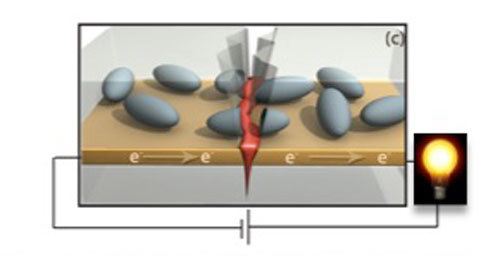
Image: Self-healing electronics. Microcapsules full of liquid metal sit atop a gold circuit. When the circuit is broken, the microcapsules rupture, filling in the crack and restoring the circuit. Credit: UIUC/Scott White.
All of this comes out of work into extending the lifetime of rechargeable batteries (see Self-healing electronic chip tests may aid space travel for more). White said that physically building new circuits every time we need new functionality may give way to circuits that last longer, circuits whose redesign is keyed more to software upgrades than constant hardware changes. Imagine cell phones rendered more sustainable by the presence of ‘self-healing’ circuitry that can repair tiny cracks that would otherwise cause the device to stop working.
Healing Spacecraft Composites
We’ll see how the electronics industry reacts to these ideas when the technology becomes generally available. Meanwhile, the implications for deep space and other environments where chips are hard to replace are clear. This in turn reminds me of a study funded by the European Space Agency back in 2006. Carried out at the University of Bristol, it involved materials that could be used on the superstructure of space vehicles. Cracks caused by temperature extremes or the impact of dust grains traveling at several kilometers per second can build up over the lifetime of a mission, weakening the structure and threatening catastrophic failure.
The Bristol team, led by Christopher Semprimoschnig (ESTEC) inserted hollow fibers filled with adhesive materials into a resinous composite similar to that used in spacecraft components. The glass fibers were designed to break when any damage to the spacecraft ‘skin’ occurred, releasing the liquids needed to fill the cracks. Semprimoschnig likened the process to what happens when humans cut themselves and their blood hardens to form a protective seal that allows new skin to form underneath. This ESA news release provides more background.
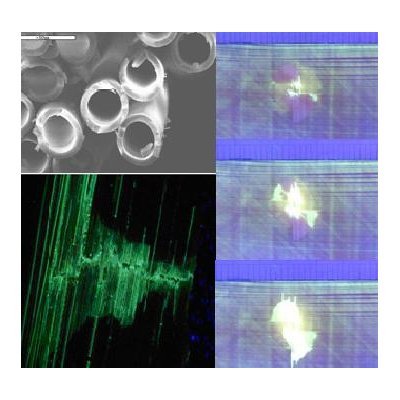
Image: Hollow fibers just 30 micrometres in diameter thread the new material. When damage occurs, the fibers break releasing liquids that seep into the cracks and harden, repairing the damage. Credit: ESA.
My assumption is that advances in both biology and nanotechnology are going to provide startling breakthroughs in materials that will make autonomous repair — whether we call it true ‘healing’ or not — possible in settings where no human intervention is possible. The worldships we talked about last week would be repaired and maintained by their inhabitants, but robotic probes on century-long journeys will need every tool in our arsenal to keep themselves functional. A truly autonomous spacecraft really does mimic biological systems in its ability to repair and adapt. Learning how to build it is a priority for future starship design.

